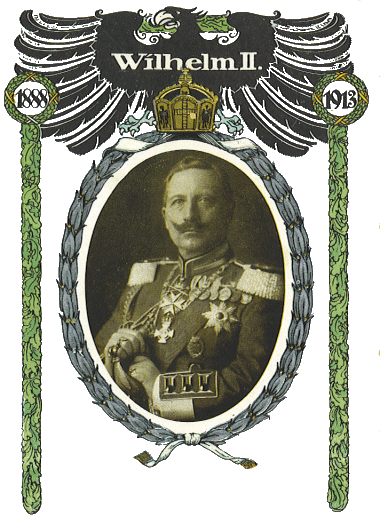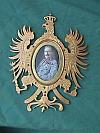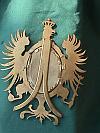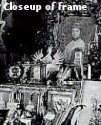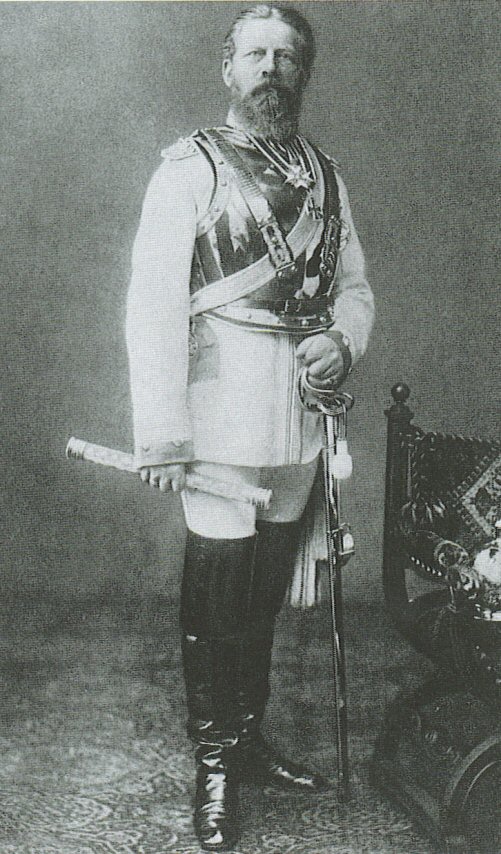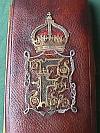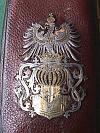|
|
|
|
Kaiser Wilhelm II
Page 2
|
|
|
|
|
|
KAISER WILHELM JUBILEE DISH (Item WILHELM 2-1) |
|
| DESCRIPTION: This is a fine nut or candy dish from Imperial Germany and commemorates so many years of the reign of Kaiser Wilhelm the Second. It is the very finest Dresden china with fine pierced trim; very colorful and inspiring to the Imperial enthusiast; historically important. It measures about 8 ˝ x 5 inches. The Kaiser and Kaiserin and the national eagle are beautifully depicted in radiant color.
PRICE: SOLD |
|
|
||||||||||
|
FANTASTIC PLAQUES OF HOHENZOLLERN KAISERS (Item WILHELM 2-2) |
||||||||||
| DESCRIPTION: This is a pair of porcelain plaques depicting the military glory of Kaiser Wilhelm I, Emperor of Germany and his son, Fredrick Wilhelm, who was crowned Kaiser in 1888, but died in the same year with his son Wilhelm II ascending to the German throne. Measuring 13 inches in diameter the plaques commemorate the victorious father and son in battle in the Franco-Prussian War, 1870-1871, which resulted in the crowning of Wilhelm I as the first emperor of a united Germany. These plaques were produced in Dresden from the bisque material that was considered so precious in its day. They are unsigned, but of Meissen or Metlach quality. The plaque of Wilhelm I is perfect except for the scabbard portion of the sword is missing. This particular part was often crafted of wood (easily replaced) because it would just be too delicate in porcelain. A minute tip of the horse's ear is also snipped, but absolutely miniscule. The reins were thread (always) because they also would have been far too delicate in porcelain. The plaque of Fredrick Wilhelm seems to be perfect all the way with the thread reins missing. All in all these wonderful porcelains are preserved for porcelain relics (well over) 100 years old. A fantastic find! Historically "super" important and gorgeous.
PRICE: $1,750.00. |
|
|
|||
|
MINIATURE PICTURES OF KAISER FAMILY (Item WILHELM 2-3) |
|||
| DESCRIPTION: These three little photographic gems are framed photos of the Kaiser; his daughter, Victoria Louise; and Prince Adelbert, the only one of his sons who entered the naval service. The other four went army, Hussars, Uhlans, etc. The photos measure 2 X 1 ˝ inches. They have little stand-ups on the back side. The paint on the 'lifesavers' is chipped in some places and an attempt at refinishing has occurred over the years, but the portrait photos are intact and clear. These are wonderful little showcase gems of the Besser Zeit. The Kaiser said in 1898 at Setten, "Unser Zukunft leigt auf dem Wasser," "Our future lies upon the water." Thereafter, many souvenirs such as these made their way to the shops in greater Germany and the Auslands. This is a rare and historically important set.
PRICE: $300.00. |
|
|
||||||
|
HAND-PAINTED MINIATURE OF KAISER WILHELM II (Item WILHELM 2-4) |
||||||
| DESCRIPTION: Here, from the Royal estate of the Kaiser Wilhelm II in Doorn, Holland, (the place of his post-WW-I exile) is one of his personal treasures. This is a wonderful rendering of Kaiser Wilhelm II, 1850-1941, Emperor of Germany and King of Prussia. His coronation took place after the untimely death of his father, Fredrich Wilhelm in 1888. He was in the unfortunate position of being literally entrapped into the First World War. He died in exile in 1941 in Doorn, Holland. A Wehrmacht cortege was dispatched by the German Chancellor A H, who respected him even though he questioned his wartime decisions. He was a complete monarchist despising all parliamentary approaches and designs. The painting is incredibly good with all orders and decorations accurate as is the marshal's uniform. The painting appears to be unsigned, although it has not been taken out of its frame. It appears to have been executed on a bone planchet as was the customary medium of the age for miniatures. If the painting is spectacular, so is the frame. It is a handmade, free-standing Imperial eagle cut out of a sheet of brass. It is expertly engraved and set with stones that may or may not be jewels. On the back is an easel-type stand. The eagle is the national symbol and is the style of the type used by the Hohenzollern dynasty in all its décor. This was a very special picture that sat among other much loved items on his desk in Doorn You can see part of this one of a kind quite unique item in the above photograph. From the cross on the crown to the bottom of the tail feathers it measures about 7 inches and from wing tip to wing tip it is 6 inches. The portrait is about 3 X 2 inches. Here is all its glory is a real piece of Germanic history in beautiful condition. One jewel is missing, otherwise, it's intact and very dramatic.
PRICE: SOLD |
|
||||||
|
LEATHER POCKET CASE OF EMPEROR WILHELM III (Item WILHELM 2-5) |
||||||
| DESCRIPTION: This is one of the most magnificent offerings concerning German Imperial history ever made on the net. This leather case is not only magnificent in its beautiful construction, but is of vast historical importance. This was the personal property of the German Emperor Frederick III, who ascended the Hohenzollern-Prussian throne in 1888. Frederick was born in 1831, the son of King Wilhelm I of Prussia at Potsdam. When his father succeeded to the throne of Prussia in 1861, Frederick became Crown Prince Frederick William. Frederick was liberal in his political views, uncharacteristic for the Hohenzollerens. He opposed Count von Bismark through his long term as Chancellor. Although opposed to the war with Austria in 1866, Frederick assumed command of the Army and led the Prussian forces to victory at the battle of Sadowa, which terminated the war which only lasted seven weeks. During the Franco-Prussian War he commanded the forces of the southern German states. He participated in the Battle of Sedan and the siege of Paris. A man of learning and culture, Frederick and his wife, the English Princess Royal Victoria (Queen Victoria's eldest daughter), patronized art and literature and encouraged the work of the royal museums. Friederich and Victoria shared the liberal principles represented by the constitutional English monarchy. The principles had not been shared by his father or Bismark, who made sure the parents did not control the upbringing of the Crown Prince. His accession to the throne was anticipated with pleasure by most Germans, who genially referred to him as 'Our Fritz.' For the Hohenzollem family and the politics of the First Reich, the year 1888 was the year of the three Emperors. Kaiser Wilhelm I died on March 9. Frederich suffered from cancer of the larynx. His poor health and untimely death were to have a profound impact on the future of Germany and Europe at large. His reign lasted only 99 days. Friedrich III died on June 15, 1888. His oldest son, the 29-year-old Crown Prince became Kaiser Wilhelm II. The possibility of this object's showing up over the many years is tantamount to a miracle; however, it is here! and offered at this time. The case is leather with the silver and what seems to be gold overlay. The detail is nothing short of fantastic, down to the slightest feather in an eagle and lines in a flower. The front side has the Hohenzollern Crown over the large 'F,' for Frederick, surrounded by knotted ropes and floral motif, while the coronet of a crown prince of the dynasty sits gently on the letter 'F.' The other side has the Royal Prussian eagle over a knight's helmet that has as its crest a prince's coronet. The metal is silver with gold. This does seem to be real gold as no brass tarnish is evident. We confess, we do not know if this case if for personal cards, or possibly reading glasses, etc., but it is certainly made with precision and artistic excellence. The two small flaps inside the case fold outward somewhat to hold something. The initials 'P.T." appear just over the place where the case snaps shut. The effect of engravers jewelling traces the frame inside the case. This is utterly and royally magnificent. The case measures almost 5 ˝ X 3 inches and is a little over ˝ inch thick. This is without a doubt one of the most historically important pieces we have ever had the pleasure of offering to museums or advanced collectors.
PRICE: SOLD |
| Page Two |
Please refer to item designator in parentheses in all correspondence.
Please E-mail for any additional information you may need.If you prefer, contact 'Germania' at PO Box 68, Lakemont, GA 30552
or call at 706.782.1668 or 706.782.4398.
Please! do not call during the wee hours of the morning. The best time for calling us is between 9 and 11 am and between 9 and 11 pm eastern time.


